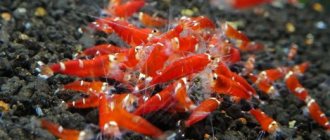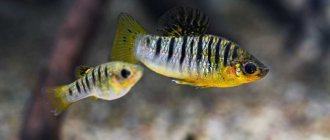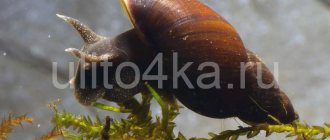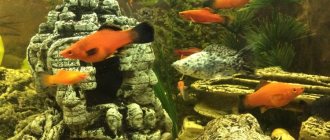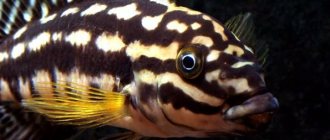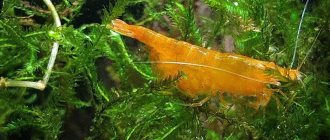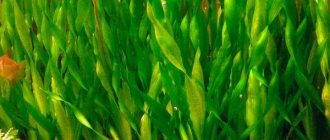An aquarium is a piece of the underwater world that can really be placed in any, even the smallest apartment. Its inhabitants do not take much time and effort from their owners to care for, you don’t need to walk with them, they don’t make any sounds that disturb people’s sleep and peace, and watching their life is a real pleasure. Fish of various colors, leisurely snails, fancy algae - all this is beautiful, but familiar to amateur aquarists. What if you add shrimp to the aquarium? Caring for them is no more difficult than caring for fish. But the “appearance”, unusual structure of the shrimp and various decorative colors will bring variety to the life of the aquarium.
Description of freshwater shrimp
Shrimp in an aquarium is a fascinating sight, as these creatures amaze inexperienced viewers with their different sizes and bright colors. Artificially bred species look especially interesting.
As for classification, these crustaceans can be divided into groups depending on their family membership or divided into two broad categories: marine and freshwater shrimp.
Many aquarists think about how long shrimp live in captivity. The lifespan of these crustaceans is 1-2 years, and large ones - up to 5 years, but in most cases, pets live for one year.
Shrimp are aquarium orderlies. They do not disdain detritus; they eat dead fish and rotting leaves of plants. They are active during the day. Tendencies towards cannibalism.
Variable features of some shrimp Neocaridina davidi
The tables show variations with less or more intense orange, pink, red color, etc. You can also see variations of Neocaridin Riley - these are clear alternating lines of different colors. These variations were released in Taiwan in 2010. At first, Riley was selectively bred from red neocardines with white spots and stripes, from which the Red Riley and Red and Blue variations were obtained. The breeders did not stop there and began to cross different color variations from the “Cherry Family”, obtaining more and more new colors. Let's look at the characteristic features of some variations of the Neocaridina davidi shrimp in more detail.
Red Rili Shrimp
The Red Riley Shrimp has all the characteristics of the Cherry, but also has a transparent middle part. It is as easy to propagate as Cherry, but looks different and is an alternative species. Caviar is yellow in color. It is recommended for beginner shrimp lovers.
Red Rili Blu Shrimp
The head and tail of this shrimp are bright red, while the middle part of the body has a sky blue color, more intense in the upper part. Caviar is yellow in color. The body is completely well painted.
Blue Carbon Rili Shrimp
The head and tail of this neocaridine are black. The black color has a shade of blue, as if covered with blue varnish. The rest of the middle part of the body has a rich transparent turquoise color, along which there are black and blue dots. Undoubtedly a very beautiful shrimp! The pale yellow eggs are very beautifully visible through the turquoise color on pregnant females. Even for a minute it seemed to me that this was an exotic cocktail in a transparent glass. The coloring is very bright and well painted.
Bloody Mary Shrimp
This shrimp has the brightest red color in this "Cherry Family". If you think that Red Fire is the brightest and that it is impossible to find a redder variation, then you need to see the Bloody Mary variation shrimp. Its color is deep red, like blood. Even the male shrimp is a deep red color, which makes them stand out from the “family” since males in other variations are usually less colorful. This shrimp isn't just red...if you look closely at it, you can see that the shell is actually different from the regular high-end Cherry shrimp. Its shell appears translucent, and the red color shines amazingly from inside the shrimp, like red light. Yes, the beauty of this shrimp deserves attention!
Painted Fire Red
This variation of shrimp was the most beautiful and colorful in the Cherry Family, before the advent of Bloody Mary. There is nothing special about this species now, except for a very good red color. The males of these shrimp are less red than the females.
Appearance
Shrimp have the following external features:
- Five pairs of legs and a tail, thanks to which the shrimp is able to jump in the water.
- Jaws designed to capture and hold food.
All types of shrimp have jaws designed to capture and hold food.
- Long antennae that look like thin antennas play the role of smell and touch.
- Large rotating eyes that provide a wide viewing range.
- Oral apparatus consisting of three jaws and jaws.
The only thing that distinguishes aquarium shrimp species from other species is the color and size of the body. In nature, there are both small shrimp that grow up to 2 cm, and large representatives that stretch up to 40 cm in length.
Table of basic parameters of maintenance, care and nutrition:
| What should be the volume of the aquarium? | 100 liters for 10-15 individuals |
| What should the temperature be? | from +18-30° C, but comfortable temperature is from +20-24° C |
| What pH should it be | from 5.5-7.5 pH |
| What should the water hardness be? | from 10° dH |
| What should the substrate be? | thin grains of the substrate (soil) ranging in size from 3-4 mm |
| What kind of lighting should there be? | moderate |
| What should be the movement of water | moderate |
| Aquarium Shrimp Size | 4-5 cm (females are slightly smaller in size than males) |
| What does it eat? | zoo- and phytoplankton on moss; dead parts of plants; corpses of small fish; shrimp granules; live and frozen food; lightly cooked vegetables |
| Who is compatible with in an aquarium? | get along with small non-aggressive species |
Types of freshwater shrimp
There are several hundred species of freshwater shrimp. Before you learn about how these crustaceans reproduce in captivity and what to feed the shrimp, you should become more familiar with the varieties of strange pets.
Amano
Amano has a translucent color in gray-blue tones. Males have dark dots on their sides, while females have streaks. Excellent control of filamentous algae in tanks, prefers to live in a school. Representatives of the species grow from 3 to 6 cm in length.
Amano has a translucent color in gray-blue tones
Harlequin
Harlequins are miniature representatives, reaching a length of 1.3 cm. Harlequins owe their unusual name to their original color: white with red, outlined in black. They lead a nocturnal lifestyle and are distinguished by their shyness and modesty.
Harlequin - miniature representatives, reaching a length of 1.3 cm
Sex differences
The female and male of this species differ quite simply. Females are somewhat larger, more colorful, and have a saddle. The female has a slight expansion on her carapace, which the males do not have.
Female White Snowflake with eggs
Before fertilization, the eggs remain in the saddle, and after fertilization, they move to the abdomen, where their further development takes place.
Keeping in an aquarium
An aquarium for shrimp is called a “shrimp tank”, and in its essence is no different from a home pond for fish. The tank capacity should be at least 50 liters, the best option is 80 liters. Parameters of the aquatic environment:
- Temperature – +18-27 degrees Celsius.
- Hardness – 1.5-2 10 dH.
- Acidity – 5.5 6-7 pH.
It should be taken into account that some types of crustaceans prefer other water parameters.
In addition, it is useful for a novice aquarist to know that pets are sensitive to changes - sudden changes in the parameters of the aquatic environment will lead to the development of diseases.
The water is changed once a week, updating no more than 40%.
An aerator and a safe filter must be installed in the aquarium, since newborn shrimp, due to their small size, can be sucked into the system. The aerator in the tank must be turned on constantly, since shrimp vitally need a large amount of oxygen.
Fine gravel is used as soil for the aquarium, the bottom is decorated with shelters and grottoes. Vegetation is planted alive, giving preference to Java moss, hornwort, and elodea, since crustaceans like to hide in plants.
Fine gravel is used as soil for the aquarium.
Many novice aquarists are concerned about the question of what to feed shrimp in an artificial pond. Most species are unpretentious when it comes to food and feed on food left behind by fish, algae and other microorganisms. Despite the fact that pets can take care of themselves, crustaceans are fed a couple of times a week using boiled vegetables or special food. In addition, you can immerse dried oak leaves in water, which are considered a good food source for crustaceans.
Shelter during molting
As the shrimp grows, its hard outer shell does not grow with it. Therefore, as they grow, shrimp molt, shedding their old cover and growing a new shell. During this period, they are very vulnerable, so you need to put several shells or hollow ceramic tubes in the shrimp tank, in which they will sit out during molting.
Fry molt much more often than adults, in the first months every 5-6 days, adults about once a month. When water parameters deteriorate, shrimp begin to shed their shells more often.
To create new defenses, shrimp vitally need calcium, reserves of which they accumulate in the body throughout their lives and are then used for molting. If there is not enough calcium to create a new shell, the animal will die. Therefore, you need to include special tablets for crustaceans in your diet, for example “Calcium Active”, or put a piece of white chalk on the bottom of the aquarium.
Shrimp farming
Breeding most types of shrimp at home is easy, as they are able to reproduce year-round. The main condition for breeding pets is clean water. The sexual maturity of female pets can be determined by special pheromones that the shrimp secretes into the aquarium liquid. It is they who make the quiet males move recklessly around the tank, demonstrating their readiness to reproduce.
Pregnancy in shrimp lasts 30 days, after which 30 miniature offspring are born.
Shrimp pregnancy lasts 30 days
If the aquarium contains only shrimp, then the newborns can be left in the old place, but otherwise the shrimp need to be transplanted. The fish, having noticed the tiny crustaceans, will definitely take advantage of the moment and dine heartily.
The most common aquarium inhabitants:
. This species is beautiful, but very demanding in terms of conditions.
Red crystal
. The Amano shrimp will feel great in an aquarium: it is a wonderful cleaner, very peaceful. But propagation of this species will be troublesome: a separate container with brackish water, lighting, a certain temperature, etc.
Amano
. But this shrimp, which has an intense red color, is no different in whimsicality. It cleans the aquarium wonderfully and gets along well with fish and other shrimp. The main thing for Mary is more moss and plants, and also clean water.
Bloody Mary
, similar in color, but slightly larger than Bloody Mary, are also perfectly adapted to aquarium life.
Cherry shrimp
another interesting representative of these arthropods. The Tiger shrimp got its name from its tiger-striped color, but these shrimp come in different colors: red, blue, black, yellow, etc.
Tiger -
This common type of crustacean also has color variations: they range from transparent to blue, brown or red.
Neocaridina Palmata.
Banana lives in its natural environment in southeast Asia and is popular among aquarists who love to breed such animals. This large specimen, clearly visible in the aquarium, has a minelike disposition, but costs a lot of money.
Shrimp filter feeder
Diseases
Like all inhabitants of artificial reservoirs, crustaceans are susceptible to various kinds of diseases. Shrimp diseases occur due to the penetration of parasites into the aquarium, which settle in the gills of pets and other parts of the body. Unfortunately, it is impossible to cure this disease, and the pet dies.
It should be noted that even careful care and monitoring of water parameters does not exclude shrimp diseases - crustaceans can contract fungal diseases. They are not as dangerous as parasitic and viral ones, but they can also be fatal. Having noticed disturbing symptoms and unusual behavior of shrimp in the aquarium, infected pets should be removed to the aquarium, the water in the tank should be replaced and a specialist should be consulted.
Prolonged immobility of shrimp is a sign of poisoning. You should immediately change 25-50% of the water. If this does not help immediately, then in the coming days make a replacement in the same volume again.
Long immobility of shrimp is a sign of poisoning
Before introducing new individuals into the aquarium, they must be kept in a separate container in quarantine for at least 14 days.
Peculiarities of reproduction of aquarium crustaceans
How do shrimp reproduce? Up to two weeks pass between mating and egg laying. Until the babies hatch, the eggs hang on the female's pleopods. During such a crucial period as reproduction, shrimp need peace and safety. Therefore, it is better to place them in a separate container, since in a common aquarium the young animals will simply be eaten by their neighboring fish.
Quite simple living conditions, unpretentiousness, relatively low cost and unusual beauty make these small crustaceans a favorite of aquarists. Observing the life of these exotic aquatic inhabitants can bring peace and harmony to a busy life. Maybe this is what attracts their owners to shrimp?
Neocaridina palmata is a rare guest in the aquariums of shrimp lovers in the CIS countries; there is very little information on it, especially on Russian-language resources. And the information that is available contains inaccuracies.
For example, on one site I read that neocaridina palmata is otherwise called the lightning shrimp because it has orange, fluorescent insides. But a caveat must be made here. When caught in the wild, palmata neocaridines do contain orange globules in the saddle area. These are encapsulated endoparasite larvae. palmata shrimp born in home aquariums do not have orange capsules inside. Market sellers also create a lot of confusion by selling outwardly similar neocaridine heteropods under the more beautiful name palmata .
Neocaridina palmata has several color variations. Depending on the lighting or food, the shrimp's body can change color and be simply transparent or colored bluish, brownish or reddish.
Imported from China as Chinese Blue Shrimps, they do have a bluish color, but when kept at home, these shrimp do not pass on the blue color to their offspring. This may be due to the type of food consumed by Neocaridina palmata in the wild, or to the activity of endoparasites in the shrimp's body.
External signs unique to the lightning shrimp include dots scattered throughout the body or a stripe of whitish or brownish colors running from the cephalothorax to the tail. Another distinctive feature, inherent only to neocaridina palmata , is orange balls, similar to tangerines or clementines, in the saddle area. These are capsules of the endoparasite (that is, a parasite that uses the host's body as an intermediate link on the way to the final host) of the spiny-headed worm Acanthocephali.
In the wild, bright orange balls, visible through the transparent body of neocaridine palmata, serve as bait for fish and birds - the final hosts, in whose intestines the parasites develop and reproduce. Remaining in the body of the shrimp in the aquarium, these worms do not continue their life cycle and are not transmitted to offspring. If an infected shrimp is eaten by a larger aquarium fish, the possibility of infection of the fish remains. Therefore, it is not worth keeping infected Neocaridin palmata together with aggressive fish. But the proximity to small fish that control the shrimp population by eating the fry is quite acceptable.
Another characteristic characteristic of neocaridine palmata is small claws at the ends of the limbs.
Neocaridina palmata is a shrimp that adapts well to various conditions, but this does not mean that its maintenance does not require any attention to the parameters and quality of water on the part of the aquarium owner.
Neocaridina palmate can withstand water hardness levels from 1.6 to 20, pH from 6.5 to 8.5 and temperatures from 14 to 32 °C. However, at temperatures above 28 °C, the shrimp stops reproducing. The optimal water parameters for neocaridine palmate are indicated at the beginning of the article.
Neocaridin palmata reproduce easily. Pregnancy lasts 3 – 4 weeks. The female is already capable of fertilization and bearing eggs at 3 months of age. At one time, the female bears up to 40 dark-colored eggs. The fry do not have a larval stage.
Neocaridina palmata is practically omnivorous. Her diet includes green and brown algae, boiled vegetables, fish and shrimp meat, oak, alder or beech leaves, decomposing organic matter in the aquarium, dry food, spirulina, and brine shrimp.
Possible mistakes and how to avoid them
Beginners make mistakes, some of which can be detrimental to shrimp:
- If the shrimp don't have enough space in the aquarium, it can lead to cannibalism. To avoid this, you should strictly monitor the number of individuals in the reservoir, and also place sufficient quantities of shelter, snags and vegetation in the container.
- Too cold or hot water in the tank disrupts the physiology of the shrimp. Sudden temperature changes should also be avoided.
- Sharp jumps in biochemical parameters can lead to the death of pets.
- Water oversaturated with oxygen can lead to air embolism. This can happen when tap water is added due to pressure in the water pipes.
- Do not pour too much water into the aquarium. Shrimp can escape from it, which will lead to their death. It is necessary not to add water 6 cm to the edge of the container.
- It is necessary to use soil specifically designed for keeping shrimp to avoid poisoning of crustaceans.
- The presence of pesticides in purchased vegetation is harmful to arthropods.
- Plants from a pet store must be kept for about 14 days in a separate tank, where the water must be changed up to 2 times a day.
- Weeding some plants, such as Vallisneria, which release poisonous juice into the water when the leaves are damaged, can cause poisoning of shrimp and death.
Decorative shrimp are the decoration and highlight of any artificial pond. Keeping and caring for these crustaceans is simple, and their bright colors and interesting behavior in the tank will definitely give the owner a good mood and many joyful and educational moments.
What to feed Far Eastern shrimp
Arthropods are unpretentious in their feeding method. They can consume specialized food for crustaceans, as well as:
- uneaten fish food;
- special food for shrimp;
- remains of other animals;
- vegetables, leaves;
- live food;
- algal fouling. Crustaceans are an excellent savior in the fight against filament. Green filamentous algae can grow throughout the aquarium, which can lead to mass extinction of higher plants and disruption of the biological balance.
This type of crustacean can compete not only for territory. Arthropods try to take control of the places where food gets most of it.
Compatible with other shrimp, snails, fish
A community aquarium is a place where you can create your own garden, which will be home to not only fish, but also other representatives of underwater fauna. Shrimp of any kind add life, naturalness and variety. Having decided to take such a step, you must remember that any animal will experience stress in a new place. It is recommended to introduce crustaceans gradually, and not all at once as a group. They will only bring benefits to the internal biobalance, as they will be the most effective cleaners.
The Far Eastern crustacean has aggressive behavior. It can cause some inconvenience to small fish and shellfish. It is better to choose neighbors by size, as well as those who swim in the middle and upper water column.
The presence of predatory fish in the tank will become a threat to the new inhabitants. Even numerous shelters and dense vegetation will not help avoid danger. Shrimp are especially vulnerable during molting. It is not advisable to keep it with the following fish: Barbus, Angelfish, Cichlids, Cockerel. It happens that not a predatory, but a large fish becomes the cause of constant stress for invertebrates: the instinct of self-preservation is triggered and crustaceans spend most of their time in shelters.
You can perfectly combine existence with catfish, Neon, Guppies, Danios, and Siamese algae eaters.
Industrial Application
Fishing for crustaceans is widespread. Modern technologies make it gentle; it is possible to control the population size without harming the environment. In addition, fishing is not allowed all year round - crustaceans are not disturbed during the spawning season.
Fishing enterprises, as a rule, do the processing themselves. After catching, shrimp are frozen directly on the ship, since they can only be stored for 2-3 hours. The product is then delivered to the plant, where it is thawed and cooked. The final buyer purchases ready-made boiled-frozen crustaceans.
They have long become popular in cooking: they are used to prepare main dishes, snacks, and can also be an ingredient in any exotic dish. The properties of shrimp meat have long been known. It contains many useful substances: iodine, phosphorus, protein. Eating has a beneficial effect on the nervous, cardiovascular, digestive, and immune systems. Shrimp are contraindicated only for those who are allergic to them.
In addition to the above beneficial properties of shrimp meat, there are also harmful ones: among all seafood it is the leader in cholesterol content. To neutralize the level of the substance, you need to consume it with plenty of greens and vegetables.

